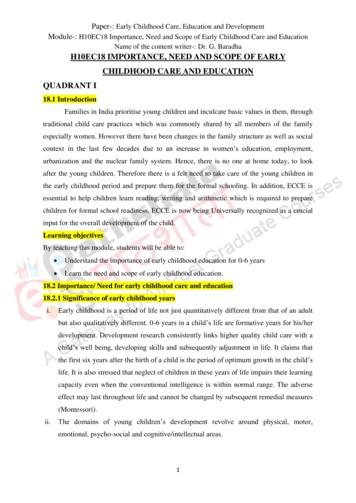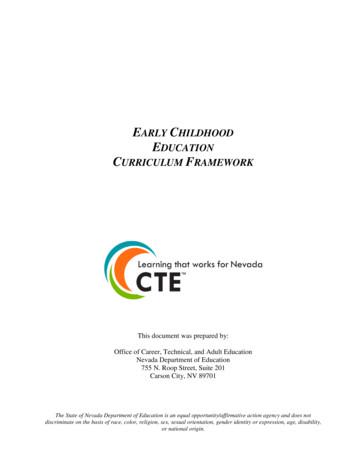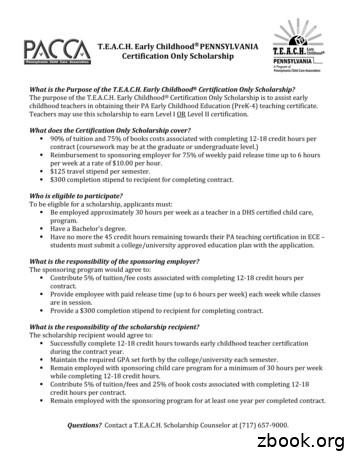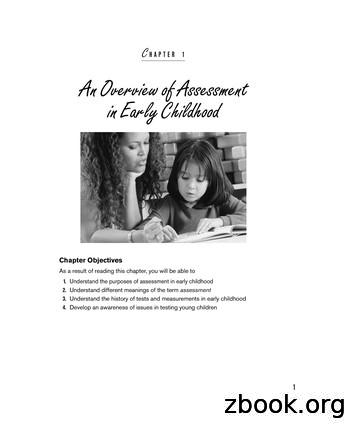Remote Learning Early Childhood Framework
Remote Learning Early Childhood FrameworkThis framework is grounded in our beliefs that the family is the 1st teacher, we meet children where they’re at, anddevelopmentally appropriate practices with a social and emotional, play-based focus is at the heart of a young child’seducation. The weekly schedule is based around when each family can attend the weekly conference. The individual learningplan is designed first with the family needs and goals for their child. In partnership, the family and teacher decide togetherwhat the weekly learning plan will look like and sound like for the child based on what the family needs, wants and can dowith their child. For any child, in any setting (childcare, at home with family, with siblings, with baby-sitter, etc.) the child mayonly participate in asynchronous learning, if that is what the family decides. The weekly learning plan will look different foreach child.FamilyLearningPlanTeacherBellingham Public Schools; August 2020; 1
Remote Learning Early Childhood Framework OverviewFamilyConferences1x/week with each family(30-60 minutes)Purpose: Connection, buildrelationship and partnerAction: Make learning goals withfamilies based on strengths andconnected to tier 1 instructionSEL InstructionTier 1 InstructionSmall GroupInstruction andEnrichment1x/day3x/day5-7x/weeksynchronous meetingSynchronous teachingsynchronous teaching( 20 minutes)( 20 minutes)( 20min)Purpose: Community buildingand SEL learningTeachers use quarterly academicbenchmarks based on essentialstandards for tier 1 instruction.Specialists can hold library,language, music class online.Can be synchronous and/orasynchronousAction: Friendship Club and/orClosing Meeting to support SELgoalsAll instructional videos(connected to the synchronousteaching experiences) will befilmed and uploaded for viewingfor families and students toaccess each week.Counselor and/or teacher holdsdaily friendship club for peer-topeer interactionTeachers give feedback tostudents digitally and/or familyconferenceBellingham Public Schools; August 2020; 2
Early Childhood Remote Learning Hold Tights (K-2)One family conference will be held every week with each family via zoom or teams. Time decided upon incollaboration with families. Conferences will last between 30-60 minutes. Schedule is family driven first, theninfluenced by teacher’s schedule.A co-constructed a 2-week learning plan will be made for student in partnership with family.WaKIDS Whole-child Assessment Teaching Strategies GOLD will guide family conferences, be used forassessment, and inform next steps for students.Three scheduled synchronous teaching experiences are available each day via zoom for families to engage in.The instruction directly connects to quarterly benchmarks. Lessons will be less than 20 minutes in length. In addition, 5-7 small group or 1:1 individualized instructional experiences per week based onstudent need.All instructional videos (connected to the synchronous teaching experiences) will be filmed and uploaded forviewing for families and students to access each week.Seesaw is used as a student portfolio system. It is the teacher’s window into the home learning. Dailyfeedback will be given in response to students’ posts. Activities can also be shared based on student need.Bellingham Public Schools; August 2020; 3
Detailed Sample Schedule – K/1Monday7:30-8:308:30-9:009:00-9:30Synchronous classmeeting lessonFamily MeetingsTuesdayPlanningSynchronous classmeeting lessonFamily MeetingWednesdayFamily Meetings9:30-10:00PlanningSmall group nous LearningSynchronous l group instructionFamily MeetingLunchSmall group instructionFamily Meeting12:45-1:15Synchronous learningSynchronous learning1:15-1:30BreakBreak1:30-2:00Teacher Office HoursFamily Meeting2:00-2:30Planning2:30-3:00Friendship ClubSynchronous classmeeting lesson1:1 ConferringSynchronous classmeeting lessonFamily MeetingFriendship ClubFridayPlanning/Collaboration (45minutes)LunchPlanning/Collaboration(45 minutes)Professional Learning (90min)Small group instructionBreakSynchronous LearningSynchronous LearningLunchSmall group instructionFamily MeetingLunchSmall group instructionFamily MeetingSynchronous learningSynchronous learningBreakBreakFamily MeetingFamily MeetingFriendship ClubFriendship ClubFamily Meeting(4:45-6:30)Family Meeting60 minFamily MeetingTeacher Office Hours3:00 -5:30Planning(330 Min Total)PlanningSmall group instruction10:00-10:305:30-6:30ThursdayPlanning60 min90 min60 min60 minBellingham Public Schools; August 2020; 4
Teacher Planning yPlanningSynchronous classmeeting lessonSynchronous classmeeting lessonSynchronous classmeeting lessonSynchronous classmeeting nchronous LearningSynchronous LearningSynchronous LearningSynchronous 12:45-1:15Synchronous learningSynchronous learningSynchronous learningSynchronous :30LunchPlanning/Collaboration(60 minutes)PlanningProfessional Learning(90 min)2:30-3:003:00 -5:305:30-6:15Bellingham Public Schools; August 2020; 5
Detailed Sample nchronouslearning9:00-9:30LearningEngagement(based onindividuallearning plan)Family MeetingSmall Groupwith TeacherLearningEngagement(based onindividuallearning plan)9:30-10:00LearningEngagement(based onindividuallearning LearningEngagement(based onindividuallearning plan)Small Group withTeacher1:1 Conferencewith TeacherLearningEngagement(based onindividuallearning plan)Bellingham Public Schools; August 2020; 6
:30PE Class Video12:30-1:00Music ClassVideoLibrary ronouslearning1:30-2:30Work Time(Plan-DoReview)Work Time(Plan-DoReview)Work Time(Plan-DoReview)Work Time(Plan-DoReview)Work Time (PlanDo-Review)2:30-3:00Friendship ClubFriendship ClubFriendship ClubFriendship ClubFriendship ClubBellingham Public Schools; August 2020; 7
Childcare Schedule :00Kindergarten &3rd gradeSynchronouslearning1st grade & 4thgradeSynchronousLearning2nd grade & n &3rd gradeSynchronouslearning1st grade & 4thgradeSynchronousLearning2nd grade & ten &3rd gradeSynchronouslearning1st grade & 4thgradeSynchronousLearning2nd grade & en &3rd gradeSynchronouslearning1st grade & 4thgradeSynchronousLearning2nd grade & 5thgradeSynchronousLearningLunchFridayKindergarten &3rd gradeSynchronouslearning1st grade & 4thgradeSynchronousLearning2nd grade & 5thgradeSynchronousLearningLunchThis model would require remote learning para professionals to each childcare site. Some paras are assignedto grades K-2 and some paras are assigned to grades 3-5. A para professionals could provide a class meeting,movement break and stream-in an asynchronous learning video from classroom teachers of the children in thechildcare. Additionally, paras could support the instruction and student management.Bellingham Public Schools; August 2020; 8
Remote Learning ComponentsTier 1 Instruction Teachers use quarterly academic benchmarksbased on essential standards for tier 1instruction. An instructional template can be used tosupport teacher’s instruction in remotelearning setting.Lessons Offer 3 whole group synchronous lessons/day,based on district created scope and sequence( 20 minutes) One classroom meeting ( 20 minutes) 5-7 Additional Small Groups/1:1, based onlearning plans ( 20 minutes) 1:1 student conferring teacher discretionbased on student needSpecialistsStudents can engage in weekly specialists (3x/week)synch or asynchronously. Families choose based onavailability and interest. Specialists provide weeklyofferingsYouTube Channel Teachers post their weekly teaching throughasynchronous videosBeginning LaunchLearning menus are provided for families to engage inwhile teachers are conferencing with each family2x/week for the first 2 weeks of school forrelationship building and assessment. Teachers willalso post daily videos during this time.Assessment Ages and Stages Questionnaire—asassessment during the first two weeks In house TSG training in the fall for all K1 teachersAcademics K-Screen/PA via zoom 1st grade—BAS on zoomSELCollaboratively place children on SEL in GOLD with familieso First the teacher is listening and placeso “This is what I think based on what I amhearing, what do you think?”o By the end of the year, families areuploading evidence of objectives toSeesawPlay 60 minutes of play every day as anexpectation. The “review” of worktime can happen in friendship club.If they can’t come to friendship club,students and families can postreflection, creation on Seesaw. Teach families about plan-do-reviewprocess and support SEL objectives. Distribute a rotation of Work Timesupplies. Para educators can supportthe delivery, pick up and cleaning ofthe supplies.Bellingham Public Schools; August 2020; 9
Family Conferences Support GuideTwo-Week Sample Family Conference Cycle GoalsSchedule is family driven first, and then influenced by teacher’s schedulePurpose:1. Building connections and relationships2. Making learning goals with families based on strengths of the child and grounded in TSG and the essential standards/scope & sequence Connect and build a relationship with family Set learning goals in partnership Collaborate on how to meet goals by making a learning plan together (synchronous learning, home experiences,resources, GOLD connections, teacher YouTube channel, Seesaw, Teams) Collaborate on daily practice jobs to be integrated into home life (i.e. practice counting to ten every day when youhave a snack by counting ten crackers; look for shapes when you go on your daily walk) Collaborate to fill out a weekly planner together detailing the plans Weekly plans are stored online for collaborative use Close with care Week 1Week 2 Connect and build a relationship with family Review learning goals and modify next steps in partnership—what’s working, what’s not? Open ended conversation “How can I support you?” (goal to ensure that family and child’s SEL and basic needs aremet) Close with care Bellingham Public Schools; August 2020; 10
WaKIDS Connection: Teaching Strategies by GOLDDuring family conferences, teachers will lean into GOLD objectives as a conferencing tool. Together, teachers andfamilies can co-create goals aligned with GOLD . Initially, teachers assess and place students on the continuumthrough family conversations and questions. As the year progresses, teachers show objectives to families andtogether, they can assess the child. With more familiarity with the assessment tool, families and teachers togethercan choose which objective to focus on, building on student strengths and family input. Families can become familiarwith the tool throughout the year and begin to upload documentation to Seesaw pertaining to the objective chosen inthe family conference.Teacher assess student using TSGTeacher begins showing family objectivesThrough familyFamily increases useconferenceconversations, teachersuseMyTeachingStrategies Families decide with theteacher whichobjective(s) they wouldlike their student towork on.Family might uploadpictures, work samplesto Seesaw portfoliobased on learningobjectives chosen.Bellingham Public Schools; August 2020; 11
Early Childhood Remote Learning Opportunities (Family)As the expert of their child, families lead and partner with teachers in developing andsupporting their child’s learning experience.One weekly family conference will be held for 30-60 minutes with teacher to connect, buildrelationships and support student growth.A co-constructed two-week learning plan will be made for student in partnership with teacher.Daily Work Time for 45-60 minutes in the home is encouraged and promoted with support fromteacher.Bellingham Public Schools; August 2020; 12
Descriptions of Schedule BlocksSynchronous Learning: Teachers convene students for whole class instruction lasting no more than 20 minutes via Zoom (or video platform). Amember from your family assists the kindergartner in accessing the Zoom meeting and camera on the Chrome Book or device provided by theschool district.Learning Engagement (based on individual learning plan): During this time, you work with the child on ideas, generated during 1:1 familyconference time, recorded on the two-week individualized learning plan drawing from the instructional tasks in the right column.Small Group with Teacher: The teacher will schedule 30 minute sessions with a small group of students to support English language arts,mathematics, science, and cognitive and social emotional skills.Friendship Club: Teacher and/or counselor will convene students together to focus on peer-to-peer interaction through games, songs, show-andtell, puppet shows, stories, etc. The purpose of this time is for students to see each other in a fun, interactive and engaging way. A member fromyour family assists the kindergartner in accessing the Zoom meeting and camera on the Chrome Book or device provided by the school district.Specialist’s videos: PE, Library Class, and Music class will take place in the form of asynchronous videos your child can watch and do on their own.1:1 Conference with Teacher: Your child’s teacher will schedule a meeting, at a convenient time for your family, to discuss what you want most foryour child during the learning day. Your family may also discuss all the ways your family is already promoting healthy development, what your childlikes to do, the students’ strengths, successful and unsuccessful times of the day and daily routines. By the end of your conference, the family andteacher will walk away with a co-created learning plan with connected, daily learning activities to work on with your child over a two-week period.These activities could take place in your weekly schedule during Learning Engagement (up to 30 minutes of engagement with you or anothertrusted adult). On the intervening week, your family will continue engaging in 1:1 conferences to check in with the family/teacher, modify/revisethe learning plan and possibly have some 1:1 instruction. Finally, this is a time when your teacher works with you to identify what learningmaterials your school will deliver to your home to support your child’s activities, including the self-selected projects in their Work Time (Plan, Do,Review) (described below).Bellingham Public Schools; August 2020; 13
Work Time (Plan Do Review):As part of the learning plan each week, families and teachers will discuss what ‘work time’ is, what it can look like and sound like, what materialsare needed and how to engage with your child during play. It is strongly suggested that students engage in 60 uninterrupted minutes of play. Whenchildren embark on self-selected projects based on interest, they begin to understand the skills that have been presented to them throughout theday and week in a deeper way. The process of “Plan-Do-Review” allows children to cement the skills and extend them by making meaningfulconnections to their own life. When a student takes charge of their own learning, they engage fully and learn more than in adult-initiated tasks.The roles of the family member and teacher are to create a rich learning environment where taking risks is a value and the students do all the hardwork of learning, while the adult merely serves as a facilitator.Plan Do Reflect:Plan: “Choice with Intention”Children make a plan for what they will do during a 60 minute (more or less) block of uninterrupted “work time”. The parent/guardian and/orteacher helps the child articulate what they will do, including identifying possible choices, if the child is unsure. The process of planning encourageschildren to articulate their ideas, intentions, and decisions. They increase their self-confidence and sense of control. Planning begins the process ofengagement in the learning leading to concentrated play that allows a child to move along a continuum with increasing complexity.Do: “Develops Competent Thinkers, Decision-Makers, and Problem Solvers”As soon as the child has made their plan, they should begin. Provide for 60 minutes of dedicated time. Through the process of ‘do’ children carryout their own ideas with the guided support of an adult. The adults are then able to observe, support, and extend the students’ play leading to adeeper level of learning.Reflect: “Remembering and Reflecting with Analysis”Once the plan has been finished, or the child has disengaged, review how things went. By using language and/or props the child should beencouraged to share what they did, reflecting on what worked as anticipated, how they adjusted to challenges and what they might do differentlynext time.Bellingham Public Schools; August 2020; 14
The interactive learning style of kindergartners must be reflected in the structure of your family’s schedule.Key considerations include: Sedentary components of the day must be separated by the more active elementsAdults should plan as many learning activities outdoors as possibleTeachers will limit whole group times interactions to 20–30 minutesThere must be a balance of adult- directed and student-initiated activitiesOutdoor time should take place at intervals throughout the day of at least 15 to 30 minutes in the morning and 30 minutes in theafternoonPlan at least 30 minutes for lunch to allow your child to eat a full meal without rushingThere should be 60–70 minutes of uninterrupted student directed learning time daily outdoors or indoorsAs the year progresses, the kindergarten schedule should evolve as discussed in 1:1 Planning with your child’s teacher.Bellingham Public Schools; August 2020; 15
Monday Tuesday Wednesday Thursday Friday 7:30-8:30 Planning Planning Planning 8:30-9:00 Synchronous class meeting lesson . Teacher Planning Template Monday Tuesday Wednesday Thursday Friday . Collaborate to fill out a
Understand the importance of early childhood education for 0-6 years Learn the need and scope of early childhood education. 18.2 Importance/ Need for early childhood care and education 18.2.1 Significance of early childhood years i. Early childhood is a period of life not just quantitatively different from that of an adult
Early Childhood Education I L1 Early Childhood Education II L2 Early Childhood Education III L3C Early Childhood Education Advanced Studies AS The core course sequencing with the complementary courses provided in the following table serves as a guide to schools for their programs of study.
T.E.A.C.H. Early Childhoodâ PENNSYLVANIA Certification Only Scholarship What is the Purpose of the T.E.A.C.H. Early Childhood Certification Only Scholarship? The purpose of the T.E.A.C.H. Early Childhood Certification Only Scholarship is to assist early childhood teachers in obtaining their PA Early Childhood Education (PreK-4) teaching certificate.
Early Childhood (K-3) Syllabus 1-4 The following diagram illustrates the connections among the Curriculum Framework, the progress maps, the Curriculum Framework Curriculum Guides and the K-10 syllabuses. Connections among the Curriculum Framework, the Curriculum Framework Progress Maps/Outcomes and Standards Framework, the Curriculum Framework Curriculum Guides and the Early Childhood (K-3 .
THE KENTUCKY EARLY CHILDHOOD PROFESSIONAL DEVELOPMENT FRAMEWORK. August 2008 . Updated May 2011 . The Kentucky Early Childhood (EC) Professional Development (PD) Framework Plan (Townley & Newberry, 2002; revised 2003) as approved by the Early Childhood Development Authority.
CHAPTER 1 An Overview of Assessment in Early Childhood Understanding Assessment in Infancy and Early Childhood Not too long ago, resources on early childhood assessment were limited to occa-sional articles in journals, chapters in textbooks on teaching in early childhood pro-grams, and a few small textbooks that were used as secondary texts in .
ECE 240 - Administration of Early Childhood Care and Education Programs (3) ECE 241 - Administration: Human Relations for Early Childhood Education (3) Colorado Mesa University B.A. Early Childhood Education - Early Childhood Special Education Advisor: Vail Shoultz-McCole vshoultz@coloradomesa.edu 970-255-2674
Early Childhood Care, Development and Education (ECCDE) is a term that is used interchangeably worldwide but refers to the same concept of early childhood education and cognitive development. The World Bank for instance refers to it as Early Childhood Care and Education, whereas UNESCO refers to it as Early Childhood Development Care.























